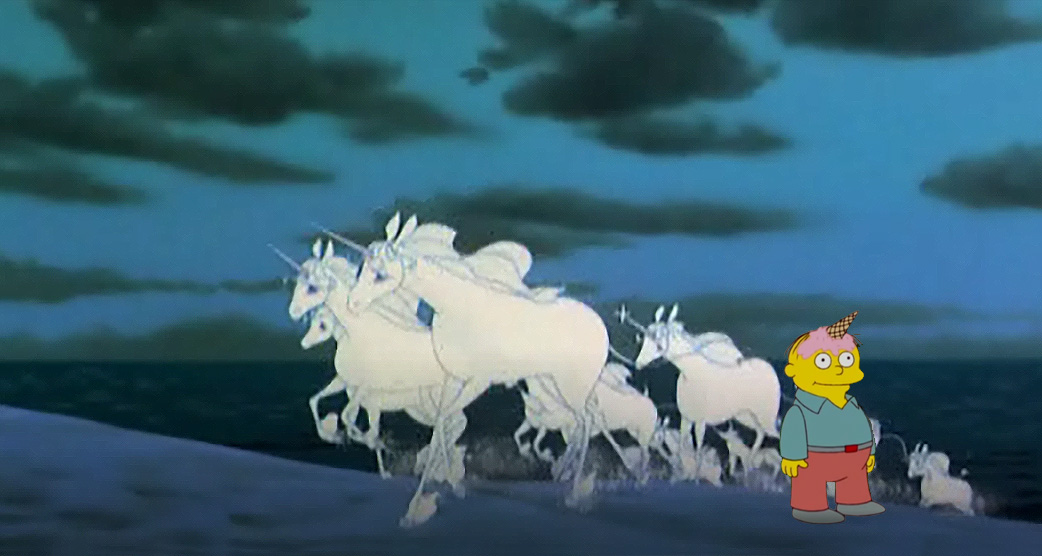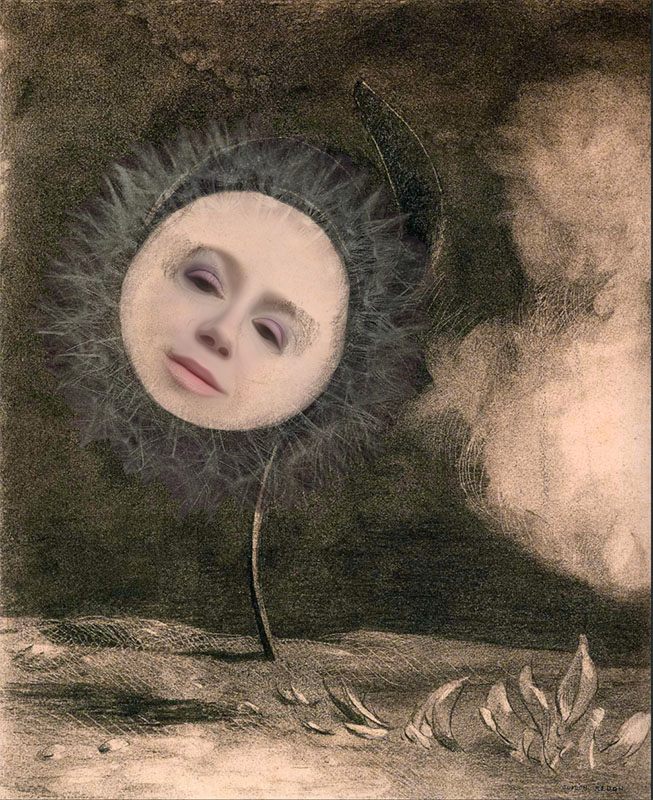Hair loss feels like such a petty, shallow, vain thing to care about, much less obsess over, until it happens to you, and then it feels like a completely reasonable sinkhole into which to fling endless resources. I’ve struggled with thinning hair since my teens, so I had it just long enough to understand its social value before it started to slide down the drain.
Losing my hair felt like the death knell to my femininity. I often feel like I’m failing at performing being a woman in the WASP-aspirational way I was raised and which society has reinforced. I’m short, thick, rectangular, and even at my heaviest, never had much in the way of land assets. Even when the fashion-minded talk about the rectangular build and how it can look good in anything, they’re talking about the tall, sleek, uber-fit rectangles, your Gwyneths and Tildas. My measurements fit the rectangle standard but looking good in the way society deems acceptable in any clothes eludes me. So instead, I tend to refer to my body as potato-shaped. I’ve mostly come to terms with it; my frame is my frame and no amount of wishing will make it otherwise. I should know, having spent an inordinate amount of time as a child wishing that someday I could go to school and unzip my body and Cindy Crawford would step out and wouldn’t that show my bullies? Somehow? The grand unzippening never happened, so here I am, a sturdy potato. It’s just…I don’t see a lot of odes to the seductive qualities of the potato. And that’s fine; my husband finds me attractive and being largely invisible to other men makes my life easier and safer. But sometimes it’d be nice to see an ode, you know? A “Damn! That potato could get it.” Losing the hair on my potato made it feel like there was nothing good about my appearance at all, that every day onward would be a deeper descent into cave trolldom.

I can’t think of a bad time that isn’t negatively enhanced by hair loss. Or a good one that isn’t slightly soured by it. It’s inescapable. Everywhere I go, there’s my scalp with less hair on it, a little misery that’s part of me. For example, when I was thirsty and tired and wrung out and fed up in Paris, I also felt bad for looking bad. It’s no secret I’m not a fan of getting haircuts, but it’s worse to pay full price for the snicking off of two wisps of hair and then leave the chair feeling devastated because they still somehow took too much. Salon small talk can be tedious, but as a balding woman, instead of small talk, I got nosy questions, semi-sympathetic pats, always followed by a product pitch of something I’ve definitely either tried or researched before. Everything is just a little bit worse.
Losing my hair in my twenties sucked, not to put too fine a point on it. It sucked getting ready to go out with my roommate, her trying something new and fun with her gorgeous mermaid hair, me left carefully arranging mine in only way I could to obscure the worst of the thinning, which because my hair is also fine and curly, meant damaging it through heat styling because curls pull what little hair there is together and expose the scalp more. This style would last for as long as I didn’t sweat or hit wet air. In Seattle. Going to hang out in crowded, hot bars and clubs. Doomed from the moment I picked up the blowdryer.

But the fun didn’t stop there. Was I going outside? Better bring a hat, lest I risk a scalp sunburn and peeling that will make it look like I have the world’s gnarliest case of dandruff. Oh, but then I can’t go anywhere afterward that involves removing the hat, because hats aren’t kind to the normal-to-thick haired (or so I hear) but they’re ruthless to the balding, matting and swirling it in the least attractive way possible. At the height of my hair loss, I would have felt less naked to be seen topless than in the vulnerable moments when I would furtively switch between my riding helmet and my baseball cap. I also needed to bring a hat if it looked like it might rain, because if my hair gets wet it’ll look even stringier. There will be absolutely no: swimming, water balloon/gun fights, spontaneous frolicking in a fountain. And slowly, over time, I became a Hat Gal, even though I’m not really a hat person and they aren’t particularly flattering, but at least they allow me to pretend anything at all might be going on underneath there in a way the hatless cannot.
There’s no such thing as a good photo when you’re balding; they all casually shatter lies told in the mirror. It’s hard to be in denial looking at photographic proof. So I’d dodge photos, mirrors (especially those nightmarish full wall jobs at the gym), reflective surfaces, and eventually social gatherings on days when I felt particularly poor about my appearance. My selfies always cut off somewhere on my ever-taller forehead. And it’d be one thing to be incapable of taking a decent photo if the result was only for me, but social media is such a huge component of acquiring any sort of following for this kind of writing. You have to project a fantasy just to capture anyone’s attention for even a moment, and no one stops scrolling instagram to fantasize about being a balding middle aged potato on vacation, much less click on her profile to find out what she’s about to even get to this blog in the first place. It feels like my chances of success are bound to my looks, and that means I get to nail myself on two accounts, for not being attractive enough to draw in a readership AND for not being a good enough writer to overcome the obstacle of being Gollum the travel blogger. And that’s a heck of a lot to put on any given photo.
Society is brutal to the balding, like it’s something we chose. “He’s such a piece of shit; look at his terrible hair.” The balding are brutalized for losing their hair, for covering up their hair loss poorly with combovers and bad wigs and hair plugs, for being vain enough to care to try, or for not doing enough about their awful hair when it’s so obvious to everyone. In fiction, it’s common for the bad or immoral characters to be bald or balding, less so a sympathetic or heroic character. In the rare case that the bald character is a woman, their heads have been shaved by someone’s choice, to empower themselves to be “more than women” (ie, like men) or have their power stripped; women with naturally thinning hair are virtually nonexistent.
“Just shave your head,” people say, as though it obscures the problem. Women don’t often go glossy bald like The Rock, and that would be the only way to hide my uneven stubble patch. And also I don’t ever want to accidentally be mistaken for a skinhead. So no, shaving is not the solution for me, but I cordially invite anyone compelled to respond to this with “Get over it, it’s just hair, it’s not a big deal” to shave their own heads before doing so. Since it’s not a big deal.
When the problem first emerged, my mother immediately found a scapegoat in a class trip to Mexico and an admittedly ill-advised and, in retrospect, culturally inappropriate set of cornrows that I got because they looked so cute on my classmate but did me absolutely no favors. I’d say it was a good thing that social media didn’t exist then but admitting their existence openly on this blog sort of negates that point. Just know that your life is better for never having had to look at them, unless you knew me during that time period, in which case you should know that your life is slightly worse for it. Anyway, she wasn’t suggesting hair loss from traction alopecia, which can be caused by the extensive wearing of tight braids (I knew mine were a mistake right away and so they didn’t last long), but rather something more nebulous and racist that she’d dance around and come right up to the edge of saying while everyone in earshot had the decency to look appalled. Even in recent years, when my mother would call me on my birthday, she’d mention what a shame it was about my hair, repeat her horrid theory of origin, and why are you so angry? I just feel like I can never say the right thing, if this is how you feel, don’t bother coming to my funeral. *CLICK*
Sometimes I think about what a loving, supportive mother might have had to say about her daughter’s devastating hair loss and its accompanying blow to her self esteem; I do this by imagining the exact opposite of whatever it is my mom actually said.

A 3.8 billion dollar industry exists to part the balding hopeful from their money, hawking hats with special hair follicle stimulating lights, pills made from shark cartilage, plasma injections, and surgeries with “minimal scarring”. I’ve been to doctors and dermatologists. I’ve taken dietary supplements and massaged in creams and unguents. I’ve used “stimulating” mint shampoo that left my head burning and trickled on dropperfuls of expensive liquids. I’ve purchased special brushes and wrapped my hair at night. I’ve co-washed and eliminated sulfates, fites, and parabens. I’ve patted on powders and sprinkled on fibers and hours later looked ridiculous as they clumped up or ran down my face. I was leery of transplantation surgery; even now, I have no idea if it is a thing that actually works. They’re all so cagey about total costs and success rates with up-front financing that it feels exactly like a for-profit college for the head. Will your hair follicles take up steady work after they’re done here? No guarantees, but you owe us the money no matter what! There are tattooists who specialize in scalp micropigmentation, in which dots of tattoo ink interspersed between hair follicles convey the impression of greater hair density, but results are only as good as the artist, it’s time consuming, expensive, and will fade over time. Short of Aladdin’s lamp, these were all the paths available for regrowth and camouflage. Were I to find said lamp, I know without a doubt that I would only have two wishes left after I used my first on a head of thick, lustrous, bouncy-with-the-perfect-amount-of-natural-wave rich girl hair. Growing out of my head, thank you very much, I don’t want any of this monkey’s paw bullcrap so I don’t want a hairstylist’s plastic practice head or Jennifer Aniston’s head in a box or some other head with amazing hair growing out of my body somewhere. I MEAN IT.
…I haven’t spent any time thinking about it at all, as you can tell.
And time kept marching forward while I researched my options and read other women’s stories and slowly struck more miracle cure hopefuls from the list, and my hair continued to thin until even my old tricks weren’t working very well anymore. Products and volumizing techniques can do a lot, up to the point where low follicle density and strand fineness intersect, when adding volume makes a human head resemble nothing so much as a dandelion in seed.
Hair loss groups online could be a double-edged sword. It was good to feel like I wasn’t alone and to read about things that people had tried with some success, but I had to limit the amount of time I engaged with them. It’s one thing to be part of a support group to come to terms with a final loss, but there’s no coming to terms with anything when there’s even a ragged scrap of a hope that things could change, especially when the issue is so tied to femininity. I didn’t find it a boon to my mental health to be in a virtual room full of thousands of other women like me in an ongoing situation, all desperate as I was to not be like me. It’s the same reason I can’t stand to be around enthusiastic dieters in any context any longer; part of so many people’s ideals about their “journey” involves loathing everything they view as being part of the “before”. But they catch so many befores in the wake of their enthusiastic self-loathing, statistically the majority of whom will never reach the after. Where do you go from there, once you’ve learned to hate yourself so well? It’s support that poisons with every touch.
Last fall, I thought, “Lots of people use wigs to look their best. Maybe it’s time to transition to being a wig-in-public person.” I went down another internet rabbit hole, found the much smaller subsection of specialty wigs that would fit my petite head (because of course, why shouldn’t I have as much difficulty shopping for wigs as I have for clothes and boots and gloves and feel like the whole package, an entire body of inconvenience?) and bought the one wig that was sort of the length and color and style I wanted, sort of. Even for a lower density wig, it was so thick that it looked deeply unnatural on my head. But I wore it around the house anyway, looking to find some level of comfort so as not to draw attention to it. On the day of its debut on a gathering with friends, I chickened out and plopped a hat on top, figuring having it poke out the bottom was a way to dip my toes. The plan was to meet up at their place, walk around downtown for the city’s annual holiday lights display, and then spend more time together afterward, but as we walked the lighted path, I could feel my wig working up off my head underneath the hat despite all the measures I’d taken to secure it. I sped up away from the group, hid behind a tree, and tried to adjust it while also struggling not to cry. This fix lasted bare minutes before the wig worked its way loose again, and my vanity and my shame were both behind the wheel when I told my friends that I had to get going and disappeared into the night rather than admit how ridiculous I am, save for when I get around to writing about it.
So wigs were not really cutting it. Or at least this wig wasn’t. After my potential coronavirus exposure quarantine in March and the subsequent shutdown of much of the country, I found a silver lining: it was time to try something else. Something you’ve probably heard of, but since this isn’t an ad or a testimonial, I’ll refer to it as medicated foam. When I saw a doctor about this issue at 20, he said that medicated foam wouldn’t work for me because it was designed for men’s hair loss. The product was introduced for women in 2014, and because of the pink tax, individual retailers still sell it at a higher price per ounce than the men’s (up to 40% more!), despite the formula and percentage of active ingredients being exactly the same. It’s also not as widely available at retailers, because of course. So for these reasons, I elected to use the men’s, which means that every time I touch the can, I see at least four reminders that it isn’t for me: MEN’s medicated foam®, not for use by women, WARNING: for use by men only, DO NOT USE: if you are a woman. I ignore them all as I purchase a three pack, admiring the absolute pettiness of spirit it must take to sell one’s product in a pack of three and then say that you should use the product for at least four months to know if it’s working, because screw you for trying, baldy!
There are a number of drawbacks to this medicated foam but only one that made it an option of last resort, and ironically, it’s one of the earliest ways you can tell if the product will work for you or not. It’s the reason that made a period of sheltering in place the ideal time to test its efficacy. That reason is The Dread Shed. You see, the active ingredient encourages new hair growth by causing hair at the end of its growth cycle to fall out, which means that about two weeks after I started rubbing foam into my scalp twice a day, hair started falling out of my head at an alarming rate. It was horrifying to rake my hand through my hair while showering and come out with a handful…over and over and over. I didn’t even know I had that much to lose! I struggled to celebrate this physical indicator of efficacy because for a while, I looked worse than ever, and if anyone other than my husband saw me without a hat during an essential outing, it was only because I couldn’t wear a hat in that environment.
Every time I rubbed the medicated foam into my thinning spots, I caught myself repeating the same mental plea. Please. Please. Please. Who did I think was listening, in charge of such a petty thing as even hair follicle distribution on my head in particular? Why do I think it would listen to my entreaties now, after all these years? And still I could not entrust my head to foam and prayer alone, having seen other women have faster or more success incorporating other steps into their routine. I would do anything to grow my hair back, I’ve said, loudly and often. Anything, I said, as I unwrapped the sterile needle-tipped roller meant to punch holes 1.5mm deep into my scalp to allow better penetration of topical solutions and stimulate blood flow to the region. Many things, I amended after the first few passes, my scalp aching and pricked with blood. Maybe I’ll just see how the foam does on its own. For science.
And then one day around three months in, I realized I felt hair, not skin, under my fingers when I shampooed. When I stepped out of the shower and looked in the mirror, I didn’t immediately feel panic and despair. It was growing back.
I’m now at the five month mark and my hair looks thicker than it has in years, with a new crop of baby hair standing straight out and haloing my head in frizz. It’s not a pretty effect. I love it. There’s just one area resisting new growth, and so I am getting over my squeamishness at hearing the sound of each of the dermaroller’s 192 individual needles break the skin in that region once a week. For science. And vanity, clearly. There’s a pandemic on, murder wasps have made it to Bellingham, and the pentagon has acknowledged that UFOs exist. I’m staying inside, tending my crop.


